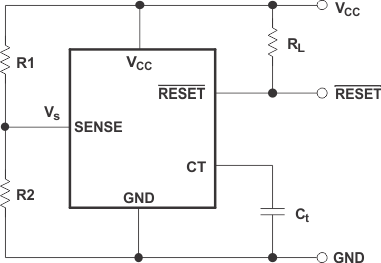JAJSH55A march 2019 – august 2021 TL7700-SEP
PRODUCTION DATA
- 1
- 1 特長
- 2 アプリケーション
- 3 概要
- 4 Revision History
- 5 Pin Configuration and Functions
- 6 Specifications
- 7 Parameter Measurement Information
- 8 Detailed Description
- 9 Application and Implementation
- 10Power Supply Recommendations
- 11Layout
- 12Device and Documentation Support
- 13Mechanical, Packaging, and Orderable Information
8.3.1 Sense-Voltage Setting
The typical SENSE terminal input voltage (Vs) of the TL7700-SEP is 500 mV. By using two external resistors, the circuit designer can set the desired sense voltage to any value above 500 mV. Based on the schematic shown in Figure 8-1, the desired sense voltage (Vs') is calculated as:
Equation 1.
where:
- Vs = 490 mV to 520 mV over temperature range
 Figure 8-1 Setting the Sense Voltage
Figure 8-1 Setting the Sense Voltage